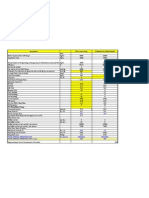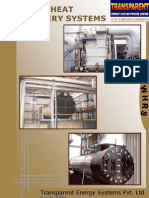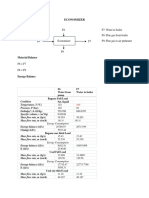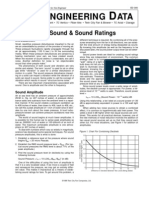0 ratings0% found this document useful (0 votes)
430 viewsWaste Heat Recovery
Waste Heat Recovery
Uploaded by
Ravi DeshmukhThis document provides information on waste heat recovery techniques. It discusses different types of waste heat recovery equipment and systems including recuperators, regenerators, heat wheels, heat pipes, economizers, shell and tube heat exchangers, plate heat exchangers, run around coil exchangers, waste heat boilers, and heat pumps. It also discusses assessing waste heat sources based on temperature and quantity.
Copyright:
© All Rights Reserved
Available Formats
Download as PPT, PDF, TXT or read online from Scribd
Waste Heat Recovery
Waste Heat Recovery
Uploaded by
Ravi Deshmukh0 ratings0% found this document useful (0 votes)
430 views32 pagesThis document provides information on waste heat recovery techniques. It discusses different types of waste heat recovery equipment and systems including recuperators, regenerators, heat wheels, heat pipes, economizers, shell and tube heat exchangers, plate heat exchangers, run around coil exchangers, waste heat boilers, and heat pumps. It also discusses assessing waste heat sources based on temperature and quantity.
Original Description:
about waste heat recovery boiler.
Copyright
© © All Rights Reserved
Available Formats
PPT, PDF, TXT or read online from Scribd
Share this document
Did you find this document useful?
Is this content inappropriate?
This document provides information on waste heat recovery techniques. It discusses different types of waste heat recovery equipment and systems including recuperators, regenerators, heat wheels, heat pipes, economizers, shell and tube heat exchangers, plate heat exchangers, run around coil exchangers, waste heat boilers, and heat pumps. It also discusses assessing waste heat sources based on temperature and quantity.
Copyright:
© All Rights Reserved
Available Formats
Download as PPT, PDF, TXT or read online from Scribd
Download as ppt, pdf, or txt
0 ratings0% found this document useful (0 votes)
430 views32 pagesWaste Heat Recovery
Waste Heat Recovery
Uploaded by
Ravi DeshmukhThis document provides information on waste heat recovery techniques. It discusses different types of waste heat recovery equipment and systems including recuperators, regenerators, heat wheels, heat pipes, economizers, shell and tube heat exchangers, plate heat exchangers, run around coil exchangers, waste heat boilers, and heat pumps. It also discusses assessing waste heat sources based on temperature and quantity.
Copyright:
© All Rights Reserved
Available Formats
Download as PPT, PDF, TXT or read online from Scribd
Download as ppt, pdf, or txt
You are on page 1of 32
At a glance
Powered by AI
The key takeaways are that waste heat recovery can save fuel by reusing otherwise wasted heat, higher temperature waste heat has greater potential value, and the quality and quantity of recoverable heat depends on its source and temperature.
The different types of waste heat that can be recovered include heat from flue gases, vapor streams, exterior equipment surfaces, cooling water, and heat stored in products leaving a process. The quality depends on factors like temperature and contamination level.
The quantity of recoverable heat (Q) is calculated as: Q = heat content in kCal, V = flow rate of the substance in m3/hr, ρ = density of the substance in kg/m3, Cp = specific heat of the substance in kCal/kg°C, T = temperature difference in °C.
1
Training Session on Energy
Equipment
Waste Heat Recovery
Presentation from the
Energy Efficiency Guide for Industry in Asia
www.energyefficiencyasia.org
UNEP 2006
2
Training Agenda: Waste
Introduction
Type of waste heat recovery
Assessment of waste heat recovery
UNEP 2006
3
UNEP 2006
Introduction
Dumped heat that can still be
reused
Value (quality) more important than
quantity
Waste heat recovery saves fuel
What is Waste Heat?
4
UNEP 2006
Introduction
Source and Quality
Table: Waste heat source and quality
S. No Source of Waste Heat Quality of Waste Heat
1 Heat in flue gases The higher the temperature, the greater the
potential value for heat recovery
2 Heat in vapour streams As above but when condensed, latent heat
also recoverable
3 Convective & radiant heat lost
from exterior of equipment
Low grade if collected may be used for
space heating or air preheats
4 Heat losses in cooling water Low grade useful gains if heat is exchanged
with incoming fresh water
5 Heat losses in providing
chilled water or in the
disposal of chilled water
1.High grade if it can be utilized to reduce
demand for refrigeration
2.Low grade if refrigeration unit used as a
form of Heat pump
6 Heat stored in products
leaving the process
Quality depends upon temperature
7 Heat in gaseous & liquid
effluents leaving process
Poor if heavily contaminated & thus requiring
alloy heat exchanger
5
UNEP 2006
Introduction
High Temperature Heat Recovery
Table: Typical waste heat temperature at high temperature
range from various sources
Types of Devices Temperature (
0
C)
Nickel refining furnace 1370 1650
Aluminium refining furnace 650 760
Zinc refining furnace 760 1100
Copper refining furnace 760 815
Steel heating furnace 925 1050
Copper reverberatory furnace 900 1100
Open hearth furnace 650 700
Cement kiln (Dry process) 620 730
Glass melting furnace 1000 1550
Hydrogen plants 650 1000
Solid waste incinerators 650 1000
Fume incinerators 650 1450
6
UNEP 2006
Introduction
Medium Temperature Heat
Recovery
Table: Typical waste heat temperature at medium temperature range
from various sources
Types of Devices Temperature (
0
C)
Steam boiler exhaust 230 480
Gas turbine exhaust 370 540
Reciprocating engine exhaust 315 600
Reciprocating engine exhaust (turbo
charged)
230 370
Heat treatment furnace 425 650
Drying & baking ovens 230 600
Catalytic crackers 425 650
Annealing furnace cooling systems 425 650
7
UNEP 2006
Introduction
Low Temperature Heat Recovery
Source Temperature
0
C
Process steam condensate 55-88
Cooling water from: Furnace doors 32-55
Bearings 32-88
Welding machines 32-88
Injection molding machines 32-88
Annealing furnaces 66-230
Forming dies 27-88
Air compressors 27-50
Pumps 27-88
Internal combustion engines 66-120
Air conditioning and refrigeration condensers 3243
Liquid still condensers 32-88
Drying, baking and curing ovens 93-230
Hot processed liquids 32-232
Hot processed solids 93-232
T
a
b
l
e
:
T
y
p
i
c
a
l
w
a
s
t
e
h
e
a
t
t
e
m
p
e
r
a
t
u
r
e
a
t
l
o
w
t
e
m
p
e
r
a
t
u
r
e
r
a
n
g
e
f
r
o
m
v
a
r
i
o
u
s
s
o
u
r
c
e
s
8
UNEP 2006
Training Agenda: Waste
Introduction
Type of waste heat recovery
Performance evaluation
9
UNEP 2006
Type of Waste Heat Recovery
Commercial Waste Heat Recovery
Recuperators
Heat exchange
between flue gases and
the air through
metallic/ceramic walls
Ducts/tubes carry
combustion air for
preheating
Waste heat stream on
other side
Inlet air from
atmosphere
Outside
ducting
Tune plate
Preheated
air
Centre tube plate
Exhaust gas
from process
Figure 1 : Waste heat recovery
using recuperator, Source: SEAV
10
UNEP 2006
Type of Waste Heat Recovery
Commercial Waste
Heat Recovery
Metallic radiation
recuperators
F
i
g
u
r
e
2
.
M
e
t
a
l
l
i
c
R
a
d
i
a
t
i
o
n
R
e
c
u
p
e
r
a
t
o
r
(
H
a
r
d
t
e
c
h
G
r
o
u
p
)
Simplest recuperator
Two metal tubes
Less fuel is burned per
furnace load
Heat transfer mosly by
radiation
11
UNEP 2006
Type of Waste Heat Recovery
Commercial Waste Heat Recovery
Convective
recuperators
Figure 3. Convective
Recuperator
(Reay, D.A., 1996)
Hot gas through
parallel small diameter
tubes
Tubes can be baffled
to allow gas to pass
over them again
Baffling increases heat
exchange but more
expensive exchanger
is needed
12
UNEP 2006
Type of Waste Heat Recovery
Commercial Waste Heat Recovery
Radiation/convective
hybrid recuperators
Figure 4. Hybrid Recuperator
(Reay, D.A., 1996)
Combinations of
radiation & convection
More effective heat
transfer
More expensive but less
bulky than simple
metallic radiation
recuperators
13
UNEP 2006
Type of Waste Heat Recovery
Commercial Waste Heat Recovery
Ceramic recuperators
Less temperature limitations:
Operation on gas side up to 1550 C
Operation on preheated air side to 815 C
New designs
Last two years
Air preheat temperatures <700 C
Lower leakage rates
14
UNEP 2006
Type of Waste Heat Recovery
Regenerator
Figure 5. Regenerator
(Department of Coal, India, 1985)
Large capacities
Glass and steel melting
furnaces
Time between the
reversals important to
reduce costs
Heat transfer in old
regenerators reduced by
Dust & slagging on
surfaces
heat losses from the
walls
15
UNEP 2006
Type of Waste Heat Recovery
Heat Wheels
Figure 6. Heat Wheel
(SADC, 1999)
Porous disk rotating
between two side-by-
side ducts
Low to medium
temperature waste
heat recovery
systems
Heat transfer
efficiency up to 85 %
16
UNEP 2006
Type of Waste Heat Recovery
Heat Pipe
Figure 7. Heat Pipe
(SADC, 1999)
Transfer up to 100
times more thermal
energy than copper
Three elements:
- sealed container
- capillary wick
structure
- working fluid
Works with
evaporation and
condensation
17
UNEP 2006
Type of Waste Heat Recovery
Heat Pipe
Performance and advantage
Lightweight and compact
No need for mechanical maintenance, input power,
cooling water and lubrication systems
Lowers the fan horsepower requirement and
increases the overall thermal efficiency of the
system
Can operate at 315 C with 60% to 80% heat
recovery
18
UNEP 2006
Type of Waste Heat Recovery
Heat Pipe
Typical application
Process to space heating
- Transfers thermal energy from process
exhaust for building heating
Process to process
- Transfers recovered waste thermal energy from
the process to the incoming process air
HVAC applications
- Cooling and heating by recovering thermal
energy
19
UNEP 2006
Type of Waste Heat Recovery
Economizer
Figure 8. Economizer
(Bureau of Energy Efficiency,
2004)
Utilize the flue gas heat for pre-heating the boiler
feed water
1% fuel savings if
60 C rise of feed
water
200 C rise in
combustion air temp
20
UNEP 2006
Type of Waste Heat Recovery
Economizer
Shell and tube heat exchanger
Used when the medium containing waste heat is a
liquid or a vapor that heats another liquid
Figure 9. Shell & Tube Heat Exchanger
(King Fahad University of Petroleum & Minerals,
2003)
Shell contains
the tube bundle,
and usually
internal baffles
to direct the
fluid
Vapor
contained
within the shell
21
UNEP 2006
Type of Waste Heat Recovery
Plate Heat Exchanger
Figure 10. Plate Heat Exchanger
(Canada Agriculture and Agri-Food)
Parallel plates forming a thin flow pass
Avoids high cost of heat exchange surfaces
Corrugated
plates to
improve heat
transfer
When directions
of hot and cold
fluids are
opposite, the
arrangement is
counter current
22
UNEP 2006
Type of Waste Heat Recovery
Plate Heat Exchanger
Run around coil exchanger
Figure 11. Run Around Coil Exchanger
(SADC , 1999)
Heat transfer
from hot to
colder fluid via
heat transfer
fluid
One coil in hot
stream
One coil in cold
stream
23
UNEP 2006
Type of Waste Heat Recovery
Plate Heat Exchanger
Waste heat boiler
Figure 12. Two-Pass Water Tube Waste
Heat Recovery Boiler
(Canada Agriculture and Agri-Food)
Water tube boiler: hot
exhaust gases pass
over parallel tubes
with water
Capacities: 25 m3 to
30,000 m3 /min of
exhaust gas
24
UNEP 2006
Type of Waste Heat Recovery
Heat Pump
Figure 13. Heat Pump Arrangement
(SADC, 1999)
The vapour
compression cycle
25
UNEP 2006
Type of Waste Heat Recovery
Heat Pump
Developed as a space heating system
Can upgrade heat >2X the energy
consumed by the device
Most promising when heating and cooling
capabilities are combined
26
UNEP 2006
Type of Waste Heat Recovery
Heat Pump
Thermo compressor
Compress low-pressure steam by very high-
pressure steam and reuse as medium pressure
steam
Nozzle for acceleration of HP steam to a high
velocity fluid.
Figure: Thermo compressor
27
UNEP 2006
Training Agenda: Waste
Introduction
Type of waste heat recovery
Assessment of waste heat recovery
28
Assessment of waste heat
recovery
Quality:
Higher temperatures = Higher quality = Lower heat
recovery costs
Quantity:
The amount of recoverable heat can be calculated as:
Heat Losses
Q = heat content in kCal
V = the flow rate of the substance in m3/hr
= density of the flue gas in kg/m3
Cp = the specific heat of the substance in
kCal/kg oC
T = the temperature difference in oC
Cp (Specific heat of flue gas) = 0.24
kCal/kg/oC
Q = V x x Cp x T
UNEP 2006
29
UNEP 2006
Heat Saving Calculation Example
Saving money by recovering heat from hot waste
water:
Q = m x Cp x T x
Discharge of the waste water is 10000 kg/hr at 75C
Preheat 10000 kg/hr of cold inlet water of 20C
A heat recovery factor of 58%
An operation of 5000 hours per year
The annual heat saving (Q) is:
Assessment of waste heat
recovery
30
UNEP 2006
Heat Saving Calculation Example
m = 1000 kg/hr = 10000 x 5000 kg/yr = 50000000
kg/year
Cp = 1 kCal/kg C
T = (75 20) C = 55 C
= Heat Recovery Factor = 58% or 0.58
GCV of Oil = 10,200 kCal/kg
Equivalent Oil Savings = 159500000 / 10200 =
156372 L
Cost of Oil = 0.35 USD/L
Monetary Savings = 54730 USD/Annum
Q = 50000000 x 1 x 55 x 0.58
= 1595000000 kCal/year
Assessment of waste heat
recovery
31
Training Session on Energy
Equipment
Waste Heat Recovery
THANK YOU
FOR YOUR ATTENTION
UNEP
32
UNEP 2006
Disclaimer and References
This PowerPoint training session was prepared as part of
the project Greenhouse Gas Emission Reduction from
Industry in Asia and the Pacific (GERIAP). While
reasonable efforts have been made to ensure that the
contents of this publication are factually correct and
properly referenced, UNEP does not accept responsibility for
the accuracy or completeness of the contents, and shall not
be liable for any loss or damage that may be occasioned
directly or indirectly through the use of, or reliance on, the
contents of this publication. UNEP, 2006.
The GERI AP project was funded by the Swedish
I nternational Development Cooperation Agency (Sida)
Full references are included in the textbook chapter that is
available on www.energyefficiencyasia.org
You might also like
- D93-20 - Flash Point by PMCC (Upgraded Feb 2021)Document18 pagesD93-20 - Flash Point by PMCC (Upgraded Feb 2021)ridermate100% (3)
- Boiler Cost Per Hour CalculationDocument1 pageBoiler Cost Per Hour Calculationsreelu100% (3)
- CBEND - Ankur WBG 400 Operation and Maintenance ManualDocument78 pagesCBEND - Ankur WBG 400 Operation and Maintenance ManualSanjivi Jagadish KumarNo ratings yet
- FD Fan Efficiency CalculationDocument6 pagesFD Fan Efficiency CalculationPraveen VaratharajanNo ratings yet
- Homework 2Document7 pagesHomework 2Chinny LyheangNo ratings yet
- C C++ in UrduDocument160 pagesC C++ in Urdumigatron74181% (32)
- Heat Exchangers & Waste Heat RecoveryDocument30 pagesHeat Exchangers & Waste Heat RecoveryrsahayNo ratings yet
- Co Generation Unit 4Document52 pagesCo Generation Unit 4Johnson Johnson100% (2)
- Power Plant and Calculations - STEAM CONDENSER, VACUUM AND CALCULATIONSDocument7 pagesPower Plant and Calculations - STEAM CONDENSER, VACUUM AND CALCULATIONSRajesh100% (1)
- Fuel Savings and Efficiency CalculatorDocument6 pagesFuel Savings and Efficiency Calculatorrajayu20002724No ratings yet
- Waste Heat Recovery BoilerDocument28 pagesWaste Heat Recovery Boilerapi-19908130100% (1)
- Boiler Thermal CalculationDocument83 pagesBoiler Thermal Calculation9913489806100% (1)
- Boiler Efficiency CalculationDocument5 pagesBoiler Efficiency CalculationMutiara ValentinaNo ratings yet
- Cyclone SeparatorDocument1 pageCyclone SeparatordadNo ratings yet
- Boilers and Steam Systems ..BoeDocument151 pagesBoilers and Steam Systems ..BoeMV AmohanAKarthicK100% (3)
- Sample Calculations of Boiler Pumps and IDDocument5 pagesSample Calculations of Boiler Pumps and IDMelvinDapitanonNo ratings yet
- Biomass Energy InstallationsDocument7 pagesBiomass Energy Installationsdrroo100% (1)
- Draft of Boiler Efficiency CalculationsDocument8 pagesDraft of Boiler Efficiency CalculationsMohsin MajeedNo ratings yet
- Boiler ReferenceDocument29 pagesBoiler ReferencetagolimotNo ratings yet
- Air HeatersDocument34 pagesAir HeatersNaveen KamatNo ratings yet
- Boiler Efficiency CalculationDocument44 pagesBoiler Efficiency CalculationgARRY100% (1)
- Plate Heat Exchanger CalculationDocument6 pagesPlate Heat Exchanger CalculationNgoVietCuongNo ratings yet
- Interpretation of Natural Draft Burner Data.: FiringDocument1 pageInterpretation of Natural Draft Burner Data.: Firingmehul10941No ratings yet
- Thermal Design of Economizer For Waste Heat Recovery Boiler WHRB IJERTV7IS100037Document7 pagesThermal Design of Economizer For Waste Heat Recovery Boiler WHRB IJERTV7IS100037Khushnood100% (1)
- Heat Balance DiagramDocument10 pagesHeat Balance DiagramJitendra Bhatia100% (5)
- Boiler Books NamesDocument12 pagesBoiler Books NamesSikander GirgoukarNo ratings yet
- Calculation of Boiler EfficiencyDocument43 pagesCalculation of Boiler EfficiencyTamer Abd Elrasoul100% (1)
- CalculationsDocument14 pagesCalculationsPratyush BadrinarayanNo ratings yet
- Huskpac UltraDocument4 pagesHuskpac UltrasebinNo ratings yet
- Use of Rice Husk As Fuel in Process Steam BoilersDocument5 pagesUse of Rice Husk As Fuel in Process Steam BoilersHinaAmanNo ratings yet
- DheerajDocument7 pagesDheerajSaksham KakarNo ratings yet
- Economize R 3 TrialDocument19 pagesEconomize R 3 TrialNitish AmnerkarNo ratings yet
- Waste Heat Recovery TechniquesDocument62 pagesWaste Heat Recovery Techniquesdhruv100% (1)
- Steam Boiler ProjectDocument32 pagesSteam Boiler ProjectSwastik BhokareNo ratings yet
- Heat BalanceDocument10 pagesHeat BalanceHoang VAN SI100% (2)
- Design of Heat ExchangerDocument26 pagesDesign of Heat ExchangerSatish YadavNo ratings yet
- Rice Brochure V1Document36 pagesRice Brochure V1Naveenraj KrishnamoorthyNo ratings yet
- Energy Performance Assessment of Boiler at P.S.S.K. LTDDocument12 pagesEnergy Performance Assessment of Boiler at P.S.S.K. LTDPajooheshNo ratings yet
- Boiler Performance CalculationDocument1 pageBoiler Performance Calculationagusnnn50% (2)
- SOx and NOx in CFBC BoilerDocument2 pagesSOx and NOx in CFBC BoilerVirendra Patil100% (3)
- Gas Flow CalculationDocument59 pagesGas Flow CalculationOmprakaash MokideNo ratings yet
- Docslide. Successful Commissioning of An Afbc BoilerDocument72 pagesDocslide. Successful Commissioning of An Afbc BoilerRakesh GairolaNo ratings yet
- 1.5 NPS RecuperatorDocument7 pages1.5 NPS RecuperatorAnonymous pVoSWn8yh0No ratings yet
- Biomass (Rice Straw) Fired BoilerDocument9 pagesBiomass (Rice Straw) Fired BoilerSnehashis MaityNo ratings yet
- Heat & Mass BalanceDocument2 pagesHeat & Mass Balancesneha_21100% (1)
- DTS - Air To Air Heat Exchanger Data SheetxlsDocument1 pageDTS - Air To Air Heat Exchanger Data SheetxlspawanroyalNo ratings yet
- (How To) Calculate The Required Blower Capacity For FBD - Pharma EngineeringDocument11 pages(How To) Calculate The Required Blower Capacity For FBD - Pharma EngineeringTerrence Terry BhengoeNo ratings yet
- Boilers and Thermic Fluid HeatersDocument42 pagesBoilers and Thermic Fluid HeatersQasimWarisNo ratings yet
- Sample Computation For Boiler EfficiencyDocument6 pagesSample Computation For Boiler Efficiencyra_tagolimotNo ratings yet
- Combustion Air Fan CalculationDocument2 pagesCombustion Air Fan CalculationVijay Bhan100% (1)
- Specific Gas Ratio - SwapnilDocument33 pagesSpecific Gas Ratio - SwapnilYhane100% (1)
- Gas Fired BoilersDocument2 pagesGas Fired BoilersCristi PopNo ratings yet
- Steam TablesDocument23 pagesSteam TablesNoerby AntoNo ratings yet
- Steam Cost Calculations 2020Document3 pagesSteam Cost Calculations 2020Malwadkar P.B.No ratings yet
- 78 - Triumph Stoker BrochureDocument2 pages78 - Triumph Stoker BrochureMatias MancillaNo ratings yet
- Best Practices in Energy Efficiency in Cement Sector CFD Final PDFDocument53 pagesBest Practices in Energy Efficiency in Cement Sector CFD Final PDFPradeepNo ratings yet
- Boiler Alkali BoiloutDocument4 pagesBoiler Alkali BoiloutBalaji PillaiNo ratings yet
- Assement of Bag Filter Vs ESP CPCBDocument133 pagesAssement of Bag Filter Vs ESP CPCBdehriya100% (1)
- Chemical Reactor Analysis and Applications for the Practicing EngineerFrom EverandChemical Reactor Analysis and Applications for the Practicing EngineerNo ratings yet
- Waste Heat RecoveryDocument32 pagesWaste Heat RecoveryManish Tiwari100% (1)
- Boilers and Thermic Fluid HeatersDocument54 pagesBoilers and Thermic Fluid HeatersAmit ChauhanNo ratings yet
- Boilers and Thermic Fluid HeatersDocument54 pagesBoilers and Thermic Fluid HeatersG.RameshNo ratings yet
- Resignation Letter Example FinalDocument2 pagesResignation Letter Example FinalRavi DeshmukhNo ratings yet
- Steam TableDocument1 pageSteam TableRavi DeshmukhNo ratings yet
- Chapter 2: Water TreatmentDocument9 pagesChapter 2: Water TreatmentRavi DeshmukhNo ratings yet
- Fan VibrationDocument6 pagesFan VibrationRavi Deshmukh100% (2)
- Ngineering ATA: Fan Sound & Sound RatingsDocument8 pagesNgineering ATA: Fan Sound & Sound RatingsRavi DeshmukhNo ratings yet
- PGDC Program BrochureDocument14 pagesPGDC Program BrochureRavi DeshmukhNo ratings yet
- Electrostatic PrecipitatorsDocument31 pagesElectrostatic PrecipitatorsRavi DeshmukhNo ratings yet
- Energy EfficiencyDocument207 pagesEnergy EfficiencyRavi Deshmukh100% (2)
- Ejector PrincipleDocument13 pagesEjector Principlekhoshya7100% (1)
- Boiler FeedwaterDocument5 pagesBoiler FeedwaterRavi DeshmukhNo ratings yet
- Bok - 978 981 15 7031 5Document1,126 pagesBok - 978 981 15 7031 5Arkendu MitraNo ratings yet
- Product Catalog: Compact Screen, Single Screen & Multi Screen FiltersDocument26 pagesProduct Catalog: Compact Screen, Single Screen & Multi Screen FiltersLuan NguyenNo ratings yet
- 01-05 Data PlanDocument19 pages01-05 Data PlanhugobiarNo ratings yet
- Lab Book Checkpoint 2Document14 pagesLab Book Checkpoint 2Ace Writer1No ratings yet
- Troubleshooting and Prevention of Cracking in Induction Hardening Os Steels - Part 2Document8 pagesTroubleshooting and Prevention of Cracking in Induction Hardening Os Steels - Part 2Jader PitangueiraNo ratings yet
- Capacitor 2Document31 pagesCapacitor 2Shaheer MirzaNo ratings yet
- SOLIDWORKS Electrical Getting StartedDocument31 pagesSOLIDWORKS Electrical Getting StartedIsaias Israel HernandezNo ratings yet
- 4 Radiobiology of Brachytherapy and The Dose-Rate EffectDocument27 pages4 Radiobiology of Brachytherapy and The Dose-Rate EffectDiana MitreaNo ratings yet
- Alignment Calculation V 107Document16 pagesAlignment Calculation V 107thummadharani66980% (1)
- K Ekkkjfffffffffffffnergy and WorkDocument33 pagesK Ekkkjfffffffffffffnergy and WorkRavi YadavNo ratings yet
- ABS 5. 3 BOSCH Braking System Training Board - Simulator: Technical Specifications and FunctionsDocument1 pageABS 5. 3 BOSCH Braking System Training Board - Simulator: Technical Specifications and FunctionsFaziri Abdul HaqNo ratings yet
- HUAWEI DBS3900 Dual Mode Base Station Hardware Structure and PincipleDocument79 pagesHUAWEI DBS3900 Dual Mode Base Station Hardware Structure and PincipleCarlos CrisostomoNo ratings yet
- VSC Catalog - EngDocument5 pagesVSC Catalog - EngmonaharaNo ratings yet
- 12 Simple Notes (EM) - 2 MarksDocument10 pages12 Simple Notes (EM) - 2 MarksNidhi100% (1)
- Number Series Coding and Decoding and Odd Man Out SeriesDocument2 pagesNumber Series Coding and Decoding and Odd Man Out SeriesSambhav GargNo ratings yet
- World's Tallest Steel Shear Walled Building: Mark Sarkisian Dasui WangDocument6 pagesWorld's Tallest Steel Shear Walled Building: Mark Sarkisian Dasui WangMichael Murfinator MurphyNo ratings yet
- Components/Parts of A System Unit: Shiela Jean Alumbro Bpa 1-CDocument2 pagesComponents/Parts of A System Unit: Shiela Jean Alumbro Bpa 1-CSHIELANo ratings yet
- 04-053-063 Grooved GasketsDocument11 pages04-053-063 Grooved Gasketsritesh sharmaNo ratings yet
- PH Meter Calibration PDFDocument2 pagesPH Meter Calibration PDFparikhjigarNo ratings yet
- Investor Sentiment Market Volatilityand IPOInitial ReturnsDocument12 pagesInvestor Sentiment Market Volatilityand IPOInitial ReturnsReact EmotNo ratings yet
- Polynomial Applications:: Perimeter, Area, and VolumeDocument4 pagesPolynomial Applications:: Perimeter, Area, and VolumeJohn Paul Basiño100% (1)
- Lecture 28 PDFDocument13 pagesLecture 28 PDFAlson BenhuraNo ratings yet
- History of The Pythagorean TheoremDocument5 pagesHistory of The Pythagorean TheoremRandy RandomNo ratings yet
- 6120be6daea4490011abe4aa-1629537650-Module 1-Lesson 2 - Part 1Document5 pages6120be6daea4490011abe4aa-1629537650-Module 1-Lesson 2 - Part 1Aldvin Jan AlcasidNo ratings yet
- D-AAA-SWG-MV-SWST-WD (Rev.0-2015)Document14 pagesD-AAA-SWG-MV-SWST-WD (Rev.0-2015)Muhammad hussainNo ratings yet
- Project Report: Faculty of Electrical and Electronic EngineeringDocument16 pagesProject Report: Faculty of Electrical and Electronic Engineeringabdikadir hassanNo ratings yet
- Leneo Fusion Instrument: Keeping Ahead Through Expertise in Sample Preparation by FusionDocument5 pagesLeneo Fusion Instrument: Keeping Ahead Through Expertise in Sample Preparation by FusionCaio JokoNo ratings yet



































































































